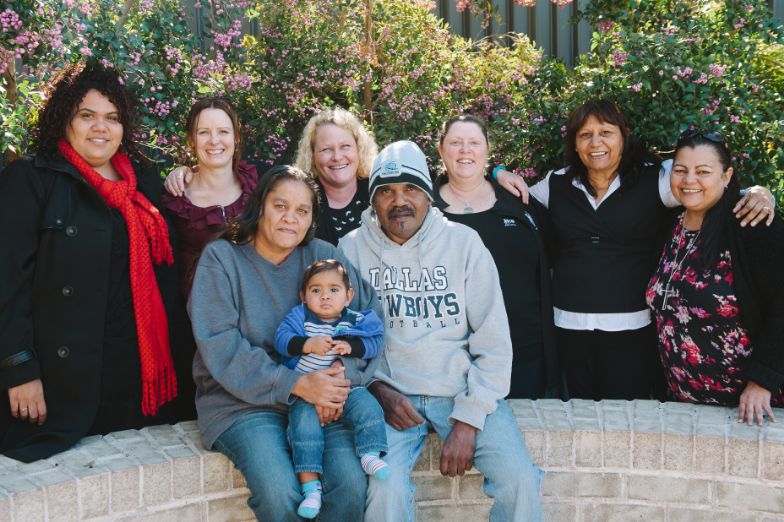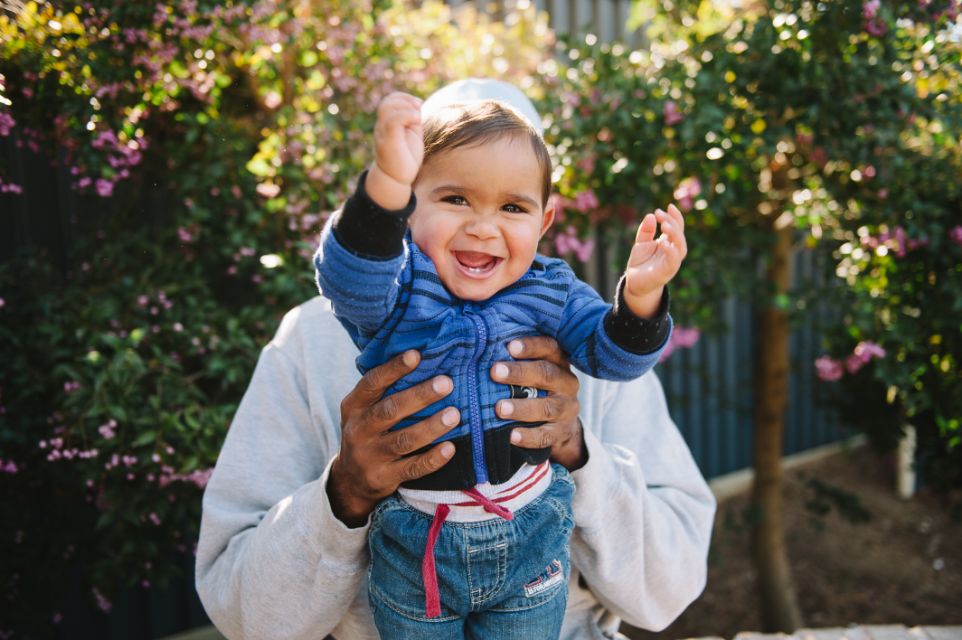Automatic language translation
Our website uses an automatic service to translate our content into different languages. These translations should be used as a guide only. See our Accessibility page for further information.

At their first Aboriginal Family Planning Circle, Dorothy, four months pregnant, and her husband, Simon, stood together cradling a baby doll. We gathered around, showing our support at the start of their journey. It was so powerful looking around at all the faces in the room. We were a team, all of us together looking out for their baby due in five short months.
A few weeks earlier, when I was given the child protection report, it was hard to find any hope. Dorothy and Simon already had five children in care, and she was pregnant with her sixth. The couple had been drinking and it had turned violent – both attacking each other. It was around that time that their local community referred them to the Circle.
The idea of the Circle was developed by a group of family support workers in the South Western Sydney area to help Aboriginal families with complex problems get support from a range of services. Its aim was to empower families to become safer and stronger for their children.
The facilitator, Cheryl, invited me, as a representative of DCJ, to be a part of the Circle. The facilitator decides who needs to be there, and people must be invited to participate. Also in the Circle were representatives from Relationships Australia and the Marrin Weejali Aboriginal drug and alcohol service, as well as an Aboriginal Health Nurse, an Aboriginal elder from the local community, and Dorothy’s mother.
I remember thinking how brave Dorothy and Simon were at that first meeting. Dorothy was strong, determined and proud, while Simon was quiet and calm. They spoke truthfully about their lives, the heartbreak of losing their children, and their own child protection history. It was an incredibly hard story to hear. What struck me was how loving and kind they were to one another despite everything. For the first time, I felt hopeful for their baby.
The Circle’s safe environment gave Dorothy and Simon, and in fact all of us, the space to talk. It meant we could acknowledge the past and agree on future goals without blame or defensiveness. Everyone has a story if we take the time to listen.
Cheryl asked Dorothy and Simon why they thought DCJ was worried about their unborn baby. They were upfront about it, speaking of their troubles with alcohol and the physical violence between them when they drink. They knew this was not safe for their baby.
Together the Circle developed an Action Plan. Dorothy and Simon agreed to give drug and alcohol counselling and AA a go. This was a huge step, as they’d rejected help many times before. Relationship counselling was also critical because they needed help to stop being violent.
To show Simon and Dorothy I was just as accountable to them as they were to the Circle, I made sure to follow through on everything I said I’d do. I attended every meeting of the Circle so they didn’t have to see a new face from DCJ each time or have to retell their story and experience the grief over and over again. The Circle was built on trust and shared responsibility, and I needed to be trustworthy to be a part of it. I wanted them to believe I was the real deal.
The Circle met each month and everyone would update each other on what was happening. The Action Plan evolved as Dorothy and Simon’s needs changed.
Every step of the way, they did everything the Circle asked of them. In fact, even before the first meeting they’d stopped drinking, which was incredible given how long it had been an ongoing part of their lives. It’s hard to know what the catalyst was – the Circle, the new baby, or it being the right time in their lives. But from that first meeting we checked regularly with police, Circle members and Dorothy and Simon themselves, and there were no reports of drinking or violence. It was looking more and more likely they’d be able to give their baby safety.

Just before bubs was born, the beautiful Baabayan women from our area hosted a baby shower, with all the Circle members invited. I loved being part of an event that celebrated this much wanted baby. We’d all been on the journey with Dorothy and Simon, and it seemed fitting that we’d come together for the baby shower too.
A few days later, a healthy baby boy – Noah – arrived. I felt deep sadness when Dorothy told me how she cried after Noah was born, terrified we were going to take him away. Her last baby had been removed from the same hospital a few years before, and the overwhelming grief of that moment bubbled up for her now. It reminded me that DCJ has so much power in people’s lives – we should never forget this.
On the way home from the hospital, Dorothy drove 40km an hour while Simon sat in the back seat to make sure Noah was okay. Even now, Simon still sits in the back whenever they go out!
Yet it hasn’t been easy for Dorothy and Simon and they have made brave choices. They choose to avoid get togethers if they know people will be drinking, and have said no relatives can drink when they come over. They’re able to make their own decisions about what is safe for their son.
Noah is now a healthy seven month old boy. He recently spent time with his brothers and sisters in regional NSW, where they are in kinship care. We did some work to make sure this would be a good time for everyone, and Noah’s brothers and sisters understood why he was with their parents and they were not. I really hope that, now Simon and Dorothy are in a better place, they’ll be able to play a bigger role in their other children’s lives as well.
When I picture Noah happy, safe and loved at home, I think about why it was so different this time around. For me, it was because the motivation for change came from Simon and Dorothy themselves, not from us telling them what to do. It was also about everyone in the Circle having the courage to be honest and to have those hard conversations and then following up with help and support.
One of the great things about the Circle is that it’s still going even though there’s no longer any involvement from me or other DCJ representatives. My last Circle meeting was when Noah was five months old, and I’m happy to say I’m no longer needed. DCJ was always just one part of the collective, and it’s wonderful the family has such support without our involvement.
I’ve worked in child protection for many years and being part of Noah’s life has filled me with optimism. It’s been an honour to share the journey with Dorothy, Simon and Noah, and I now share their story with expectant mums who are losing hope, terrified they lack the strength to be the parent their baby needs.
I tell them it is possible – you can change. This story is proof.
When I became pregnant with Noah, I knew I had to keep this baby. My heart was gone from when my other children were taken from me, and I couldn’t live through that again.
I didn’t have any support with my other children, so I was shocked when I walked into the Aboriginal Family Planning Circle and saw that so many people cared enough to turn up. The difference with Noah was I had a whole team of people around me and I wanted to show them I could be a good mum. I was still nervous they were going to take him; it took me a long time to realise they actually wanted to help. Now Simon and I wish we’d had this opportunity a long time ago, and we hope other families get the same support we did.
Having Noah at home with me is everything. I just want to get my other kids back now and be a good mum to them and Noah.
Executive Director, Strategic Policy, Department of Family and Community Services
This is a story of strength and determination. Dorothy and Simon made a decision to make a change and did the hard work that was required.
It is a story that reminds me that for so many of our clients we can’t begin to talk about the future without understanding the past.
Aboriginal people have talked about the need for healing for many years. Healing is a process, not a one-off event, and it includes recognising how past trauma and loss continue to have an impact today. For government workers, I think healing includes changing the relationship between government and Aboriginal people.
To me, this story is a concrete example of how good practice can be a step in the healing process: Elizabeth participated in the Circle because she was invited; the Circle actively listened to stories that were hard to hear; Dorothy and Simon were asked for their views about why they were there. Only then did the group develop actions.
Quite rightly, this piece is the story of Dorothy, Simon and Noah. Elizabeth has written herself in the background, probably understating her work supporting, listening and following through. When I read her final paragraph, I smiled as her satisfaction shone through. I am delighted that good casework feels good too.
16 May 2023